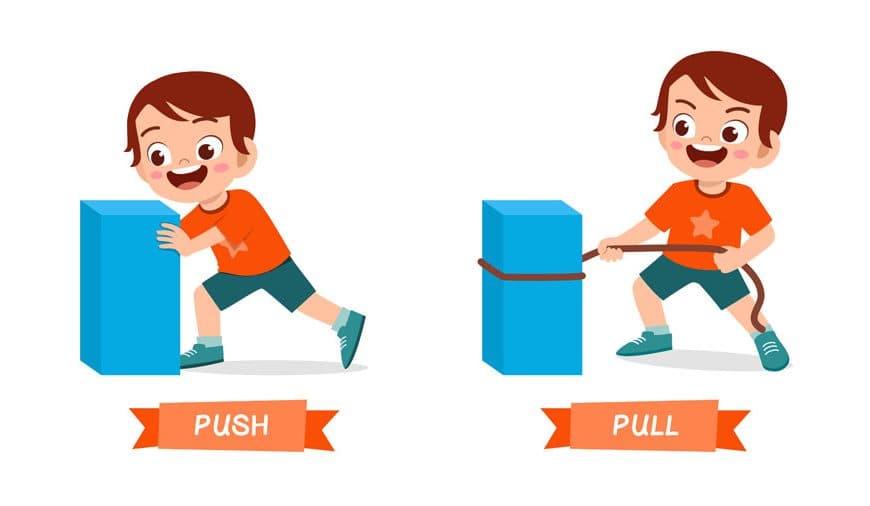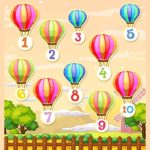Young children love exploring the world by moving their bodies and observing how things move around them. Simple actions like pushing and pulling, known as forces, are a big part of how they interact with objects and their environment. These push and pull forces can make things move, stop, speed up, slow down, change direction, or even change shape. Everyday push and pull examples include throwing, hitting, kicking, or catching, as well as forces like gravity and friction. While toddlers and preschoolers may not fully understand the concept of push, pull, and other types of forces, they can start discovering how these forces work through fun and simple activities. In this article, we will examine push and pull forces in detail.
Push And Pull Forces for Children: Knowing the Difference
Force is defined as an interaction that causes a change in the motion of an object when unopposed. Force is often described as a push or pull resulting from object interaction. For example, a force that moves an object away from you is a push, while one that moves it closer to you is a pull. These two types of forces form the foundation of how objects interact and move.
Push force is defined as the force that moves an object away from the source of the force. For instance, opening a door by pushing it, pushing a shopping cart, or pushing a swing forward.
Pull force, on the other hand, is the force that brings an object closer to the source of the force. For example, closing a door by pulling it, pulling a wagon, or pulling a rope during a game of tug-of-war.
Push and Pull Activities for Kids
Young children are naturally curious about how things move, stop, and change direction. They experience push and pull forces in everyday play, even if they don’t realize it. We have listed a few simple push-and-pull activities that parents can try at home or outside with their kids.
- Toy Car Races
- What happens when you push harder?
- How can you make the car stop?
- Tug-of-War
- Sliding and Dragging Objects
- Rolling Balls on Ramps
- Swing Time
- Building with Blocks
Grab some toy cars and create a simple race track. Ask your child to push the cars and see how far they go. Then, challenge them to gently pull the car back to the starting line. This activity introduces them to the concept of force – a gentle push moves the car slowly, while a stronger push makes it go faster and farther.
To make this activity more interactive, ask these to your kid:
Tug-of-war is a classic game that teaches push and pull forces for children. Use a sturdy rope or even a long scarf. Split into teams or play one-on-one. Your child will feel the pulling force in action and learn how it works in opposition.
Gather items of different sizes and weights, such as a plastic bin, a small basket, or a toy box. Let your child experiment by pushing and pulling these objects across the floor. Discuss how heavier objects require more force to move.
Create a ramp using a sturdy board or a piece of cardboard. Roll balls of different sizes and materials down the ramp. Encourage your child to push a ball up the ramp and observe what happens. This activity combines both pushes and pulls while introducing gravity.
Head to a playground or use a backyard swing. Show your child how pushing makes the swing move forward and pulling it back helps it gain momentum. They’ll enjoy the ride while learning about pushes and pulls in motion.
Stacking and knocking down blocks is a simple yet effective way to demonstrate push forces. Encourage your child to gently push a block tower to see it wobble and then give it a stronger push to knock it over.
How Do These Activities for Push and Pull for Kids Help?
Children develop a deeper understanding of push and pull forces. They also improve their motor skills, observation, and problem-solving abilities. Most importantly, they have fun while learning!
Encourage your little ones to experiment, ask questions, and discover how forces shape the world around them. These playful moments are the perfect way to nurture a budding scientist at home.
At EuroKids, we believe that learning about push and pull the most vital exercise for children. When they come to harbour a clear understanding of these vital concepts, they gain an understanding of other important concepts, like speed and direction.
Summing Up
Whether it is flying a kite high in the sky or sending a quick text message, pushing and pulling are a part of almost every action we take. By introducing your child to these basic forces, you help them understand how the world around them works. You can use the above-mentioned fun activities, push and pull games to spark their curiosity and make learning about force fun and educational. If you want to create a safe and fun learning environment for your little one, check out our blog, A Fun Based Learning Environment For Infants & Young Children, for ideas.
Also, check out the EuroKids Blog for more accurate information on your little one’s growth, development, health, and nutrition. And when it’s time to embark on your child’s educational journey, check out EuroKids Preschools—nationally recognized for providing the perfect foundation for young learners!















